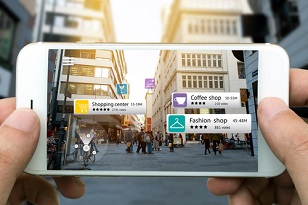7 questions to help choose the right approach for your credit union
Credit unions often wonder whether their growth strategies should include more emphasis on emerging technologies like virtual reality and augmented reality to keep their current members wowed and attract new ones.
Making those decisions can feel like a high-wire act—be the first to invest in a hot, new technology and risk falling for the wrong passing fad, or play it too safe and watch as your members get bored and head to your competition in search of more exciting offerings.
One thing is clear: There’s a lot of hype surrounding the VR/AR field. Market projections are so mind-bogglingly huge that it can be hard to separate irrational exuberance from garden-variety enthusiasm. We at PSCU recommend this summary of a 2016 analysis from Goldman Sachs as the clearest-eyed discussion of VR/AR and its market potential that we encountered in the course of our research.
7 Vital Questions About VR/AR
Our team here at PSCU’s Solutions Consulting has been studying the VR/AR market in general and its possible applications for financial services in particular. There’s a simple way to avoid not only the timing worries but the buyer’s remorse (and bad “Matrix” jokes) that could accompany a big investment in VR/AR or any new technology: Approach the issue exactly the way your credit union would analyze any other important business problem. That means asking these seven questions.
1. VR and AR 101: What are they and how are they different?
One way to think about the difference between virtual and augmented reality is to envision them as different sides of the same coin:
- Virtual reality uses computer simulations to create environments that seem lifelike. Users wear headsets to experience the simulated reality firsthand, primarily through vision and hearing. Examples are flight simulators for pilots and cutting-edge video games.
- Augmented reality layers computer-generated information on top of existing reality. AR can be delivered through wearables, such as goggles, but special headsets are not required. Examples are medical devices that overlay information onto scans, or the popular mobile game Pokémon Go.
The use cases for each technology are very different—as are the costs and barriers to entry. So although VR and AR may often be discussed together, it’s best for credit unions to evaluate each technology independently.
2. Will VR and/or AR advance your credit union’s strategic growth goals?
If your credit union could ask only one question from this list, this is the one. That’s because it focuses the VR/AR discussion squarely on what Gartner Director of Research Augie Ray calls the “what’s in it for me” factor.
In his webinar (registration required) titled “Virtual Reality: What's Real, and How Marketers Should Prepare,” Ray reviews the state of the VR market and introduces the acronym “GAME UP,” which I’ll explain momentarily, to help companies evaluate VR’s fit with their strategic goals.
Ray also designed GAME UP to help organizations avoid the temptation to sell themselves on a technology first and retrofit their goals afterward to justify their decision. (It’s been known to happen.) GAME UP stands for:
- Goals: Will VR/AR technology improve your members’ journey? Will it give them more confidence, build their loyalty and generate greater affinity for your CU?
- Audience: Does your audience (in this case, your existing members) own the necessary devices, or are they willing to buy them, and do they have the time, knowledge and interest to use them?
- Metrics: How will your credit union develop metrics to measure successful implementation of its VR/AR technology? How can your credit union be sure those metrics measure success as low in the sales funnel as possible (e.g., tracking the number of members who download purchase information rather than eyeballs that view a banner ad)?
- Extensions: How can your credit union maximize the number of uses for VR/AR (e.g., training, product education, anti-fraud applications, virtual branches, etc.)?
- Usability: How intuitive and easy to use is the VR or AR application? A key variable to consider is that financial services products require a great deal of explanation as it is. Having to explain the technology that will then be used to explain your credit union’s product or service creates a burden for both your members and employees.
- Promotion: If your credit union invests in VR/AR technology, will it have the budget left over to promote it properly?
 3. Will your current members embrace and use VR/AR?
3. Will your current members embrace and use VR/AR?
A vital additional distinction is between VR/AR’s fit with your credit union’s current members and the new members it hopes to attract. Answering this question truthfully requires the same insight into your membership as the GAME UP questions above seek.
Because most credit unions have membership requirements, the demographics and behaviors of your current members tend to predict those of your new members. That means it’s probably wishful thinking to believe that offering VR/AR will somehow magically attract droves of millennial gamers to your credit union’s doors. Remember that just because younger generations may be more comfortable with technology doesn’t mean that technoloy will automatically be a selling point.
4. What are the financial and competitive risks involved?
The financial risks of launching a modest VR/AR effort need not be large. Inexpensive viewers like Google Cardboard can provide the kind of entry-level VR experience that could set your conference or promotion apart.
However, when it comes to both hardware and software, it’s probably accurate to say that your credit union will get what it pays for. Headsets like Oculus Rift are expensive and, to work properly, require computers with the power to support gaming graphics.
But the real costs of VR/AR are incurred on the software development side—and they’re not limited to financial expenditures. That’s because entertainment and consumer brands with unlimited budgets have raised the bar so high on production values that it can be better not to attempt VR at all than to blow your credit union’s budget and produce a disappointing effort.
5. How does your credit union envision leveraging its VR/AR technology?
Building on the financial section above, it’s a rare credit union that will have the resources to develop a VR/AR effort aimed strictly at its members. (It’s a rare bank, too.) Therefore, think of VR/AR as an amortization challenge, and ask how and where your credit union could spread its startup costs across tasks and departments.
For example, could your back office use the new Microsoft HoloLens to create 3D “mixed reality” business intelligence and interactive dashboards? Could your credit union bring more members to its branch network by creating events that use the novelty of AR/VR to teach them more about topics like saving for college or retirement? Could your call center use VR to deliver anti-fraud training or disaster recovery protocols? Could your CU use AR to reach out in a fun, relatable way to unbanked segments in your community?
6. What lessons can early VR/AR adopters teach us?
The overriding lesson from early financial services VR/AR efforts aimed at consumers is that they must transcend gimmickry to add genuine value to their decision-making processes or positively influence customers’ motivations to save and invest.
Financial institutions often worry that their products are complicated and boring, but that’s not necessarily the problem. The more intractable issue is that when customers “spend” money at a credit union or bank, they don’t walk out with anything tangible to show for their virtuous actions.
Is a VR or AR experience tangible enough to address that need? Early reports of retirement planning apps indicate that viewing computer-generated versions of themselves at retirement age can help investors delay gratification.
7. Where should your credit union go from here?
I want to close this look at the VR/AR landscape with two recommendations:
- Concentrate on compelling storytelling and wait for VR/AR technology to become more mainstream. Memorable imagery has the power to convince and convert, but visual tools are available right now at much lower cost through videos and infographics. Explore Google Spotlight Stories without the benefit of 3D to see what we mean.
- Leverage CUSOs’ negotiating power when the time is right. The additional leverage of a CUSO, working with the AR/VR providers that survive the inevitable industry shakeout, will give your credit union a far greater competitive advantage than being first to market ever could.
Arnie Goldberg is VP/solutions consulting at CUES Supplier member PSCU, St. Petersburg, Fla. Goldberg draws on more than 30 years of consulting, CRM, payments and funds transfer expertise to help credit unions achieve innovative, measurable improvements to their products, operations and profitability.





